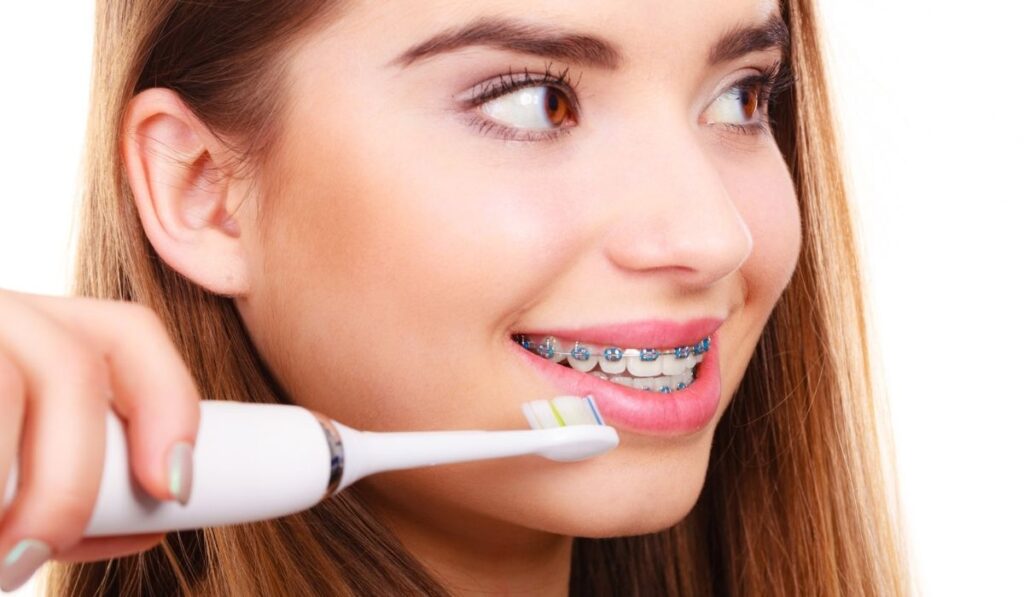An electric toothbrush can actually be a great way to maintain your oral hygiene. The ease of use, accuracy, and features an electric toothbrush provides certainly make it worth the price. Electric toothbrushes can also be a great choice if you have braces.
You can definitely use an electric toothbrush with braces. In many cases, an electric toothbrush can be better than manual options, since the moving bristles will scrub teeth better. All you have to do is pick the right model for yourself, keeping in mind features like pressure sensors and timers.
Electric toothbrushes are mainly either battery operated or rechargeable. Rechargeable ones usually consist of features such as timers, motion sensors, and more. However, they also come with a higher price tag. Let’s look at a few more details, then explore a list of models and features you can use to decide the best kind of electric toothbrush for you.
Benefits of Using Electric Toothbrushes

While electric toothbrushes might sound complex or even unnecessary to some, they can actually be quite beneficial to your oral and dental health. From a more precise brushing mechanism to better ease of use, an electric toothbrush can be a great upgrade for your dental health.
Here are some of the main features that make electric toothbrushes beneficial to your oral health.
Ease of Use
Electric toothbrushes help with an automated cleaning action. This clears you from manually having to brush your teeth, bringing more ease to your brushing experience.
The motorized rotations also help clean areas which are difficult to get to. For people with movement illnesses or arthritis, electric toothbrushes have proved to be much more easier to use, since you don’t have to manually clean your teeth.
Better for Kids
Electric toothbrushes have shown to be more effective when it comes to kids, as compared to their regular manual toothbrushes. The automated brush ensures that all parts of their teeth are cleaned accurately.
Along with that, children have also shown more interest in electric toothbrushes, making the brushing experience more fun. This is important and helps children develop an interest in their dental care from an early age.
Packed with Features
Electric toothbrushes are packed with features that can be used to help improve your dental hygiene. Some electric toothbrushes have specific modes for sensitive teeth and gums, catering to your needs.
You can also get features such as pressure sensors and timers to help you understand how much time you’re spending, if it’s enough, or if you should be brushing your teeth longer. For this, we recommend the Philips Sonicare 4100 Power Toothbrush, Rechargeable Electric Toothbrush with Pressure Sensor (on Amazon).
Electric toothbrush models also come with digital reminders to change the brush heads. In a busy schedule it’s easy to forget to change the brush head or remember how long it’s been.
Bluetooth connectivity helps you to track and connect your activity and then later monitor it. You may find patterns of brushing which you might need to change. For this, we recommend the Philips Sonicare ExpertClean 7500 Bluetooth Rechargeable Electric Power Toothbrush (on Amazon). Moreover, a lot of models come with real-time tracking to remind you to cover all the brushing area.
Electric toothbrushes have also shown to be more effective at removing plaque. This means they are better at preventing cavities, gum disease, and overall tooth decay. The oscillating toothbrushes have shown to work better as compared to ones that just vibrate.
All-in-all, with all the features you get, you’re also helping the environment by reducing the amount of plastic waste which is caused by throwing away regular disposable toothbrushes.
How to Use an Electric Toothbrush with Braces

Got braces and still want to use an electric toothbrush? Fortunately, there’s a way you can get it done without having to hurt yourself or damage your braces.
Before you start, make sure you have a few things in order, after which you head to the sink and start brushing your teeth. Here are some steps you should consider before moving on to brushing:
Talk to Your Dentist
This might sound boring or lengthy, however consulting your dentist or orthodontist before getting an electric toothbrush is highly recommended.
Electric toothbrushes tend to come in different models and variations. Coupled with braces, this can sometimes be a complicated situation where you should seek advice from your dentist.
Pick the Right Toothbrush
As mentioned, electric toothbrushes come in various models. The main two are battery-operated ones and rechargeable ones.
Battery operated toothbrushes usually run on AA batteries. Along with that, these brushes tend to offer either a spinning or a pulsating motion to help brush your teeth. Battery-powered toothbrushes are also cheaper, compared to rechargeable ones coming in with a price tag of anywhere from $5 to $25.
Rechargeable electric toothbrushes work by usually plugging into the wall, and you don’t need batteries in them to operate. These brushes usually offer more high-end features, such as specific sensors and oscillations. The electric motor here also provides more power.
With the high-end tech also comes a higher price tag. These toothbrushes can cost anywhere from $50, $200, or even more depending on the set of technology and features.
Consider the Features
Electric toothbrushes come packed with various features and technologies. It’s worth looking at which is the best one for you and also watch out for overpaying for features you might not even use.
Features include timers, motion sensors, compatibility for different brush heads, various brush settings, and a lot more.
Finally, once you’ve ticked off these necessary steps, it’s time to brush your teeth. Brushing with braces on can already be tricky, having an electric toothbrush can take things a step further, especially if you’re new.
Steps to Use an Electric Toothbrush with Braces
- Rinse your mouth with water. The water will help flush out any food particles which might be stuck in your teeth.
- Hold the toothbrush under running tap water. This will help clean the toothbrush from anything which might have gotten stuck in it.
- Apply the toothpaste on your brush. We recommend using fluoride toothpaste to ensure healthy teeth, like Colgate Total Whitening Toothpaste (on Amazon).
- Start brushing. Your mouth is divided into 4 sections (upper right and left, lower right and left). You should spend at least 30 seconds in each section.
- Hold your toothbrush against the line of your gum. It should be above your braces and on the top row of your teeth. When with the gum line, the toothbrush should be at a 45° angle.
- Brush the outer surfaces of your teeth by keeping the toothbrush at a 45° angle.
- Clean the inner surfaces of your teeth. Instead of manually moving your arm around, you can just let the toothbrush do the job.
- Brush the biting surfaces. These are the bottom or top edges used to bite into food. Try rotating motions to get a better cleaning experience.
- The area between your braces is also very important to clean. Once done with everything else, brush in-between your braces.
- Rinse your toothbrush.
It’s important to remember that you should avoid applying any heavy pressure on your braces. The advantage of having an electric toothbrush is that you don’t have to manually apply pressure.
Can You Brush Your Teeth Too Much With Braces?
It’s true that braces can bring about some changes in your normal brushing routine and techniques. However, some things should not be a problem, such as brushing your teeth too often.
If you follow the recommended brushing by dentists, you should have no problems. According to most dentists, you should brush your teeth at least thirty minutes after every meal, which means a maximum three times a day.
This brushing is necessary and important. It helps keep your mouth clean from food particles and prevents the development of plaque. Brushing is also an extremely effective way of cleaning around your braces and removing food debris which might get stuck.
If you stop brushing your teeth, you can run into numerous problems such as tooth staining, cavities, plaque buildup and overall tooth decay.
Other Tips for Caring for Your Braces
Having braces can also be a responsibility. However, with a few tips and tricks on how to look after them, you’re good to go. Here are some tips for caring for your braces.
Use a fluoride toothpaste. Most orthodontists recommend fluoride toothpaste when brushing teeth, you can go with almost any brand.
You should also regularly change the brush heads to keep your toothbrush and your oral health clean. You should change it every three months to stay safe.
Flossing your teeth is also extremely important. However, it becomes critical when you have braces. But don’t pull the wires too hard when flossing, or you can risk breaking the braces or even pulling them out.
If flossing with braces is difficult, waterflossing is a great alternative. It’s easier than string flossing around a bunch of wires and bands. A great choice is the Waterpik Cordless Pearl Portable Water Flosser (on Amazon). Waterflossing and electric brushing usually are both recommended for orthodontic patients since they are at such a high risk for cavities.
You should also rinse your mouth with water. Once you’re done brushing, take a sip and rinse. It helps clear your mouth from any leftover food debris.
Finally, it’s recommended by dentists to brush your teeth at least twice a day and floss at least once a day. But according to orthodontists, those with braces should brush and floss more than the regular patient. Due to the risk of cavities and plaque buildup around wires and brackets, it is typically recommended to brush and floss thirty minutes after every meal.


